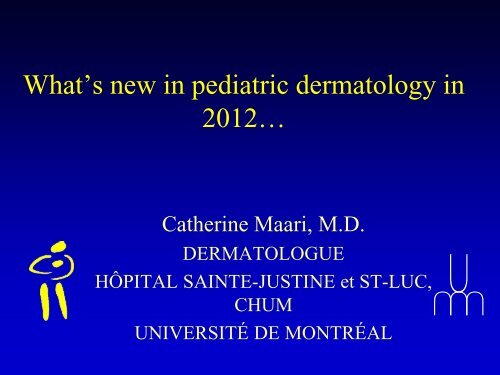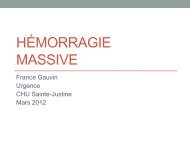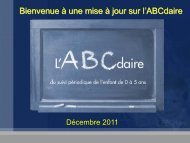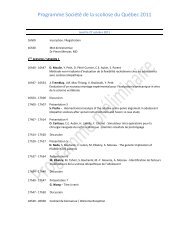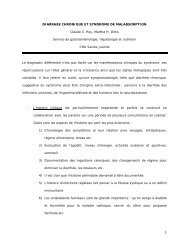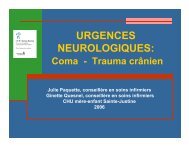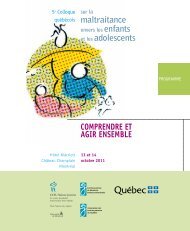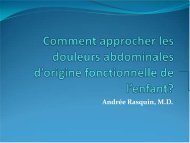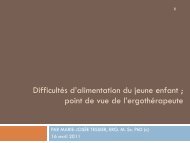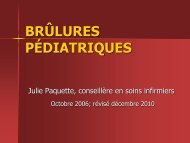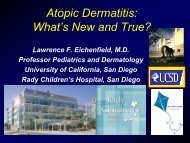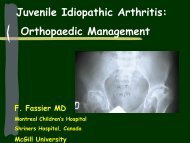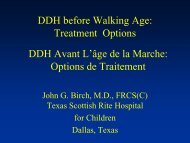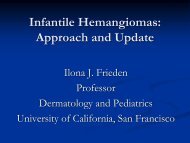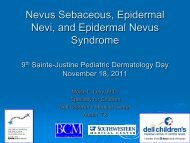What's new in pediatric dermatology in 2012… - CHU Sainte-Justine ...
What's new in pediatric dermatology in 2012… - CHU Sainte-Justine ...
What's new in pediatric dermatology in 2012… - CHU Sainte-Justine ...
Create successful ePaper yourself
Turn your PDF publications into a flip-book with our unique Google optimized e-Paper software.
What’s <strong>new</strong> <strong>in</strong> <strong>pediatric</strong> <strong>dermatology</strong> <strong>in</strong><br />
<strong>2012…</strong><br />
Cather<strong>in</strong>e Maari, M.D.<br />
DERMATOLOGUE<br />
HÔPITAL SAINTE-JUSTINE et ST-LUC,<br />
<strong>CHU</strong>M<br />
UNIVERSITÉ DE MONTRÉAL
The selection criterias…<br />
• Pubmed: <strong>pediatric</strong>, children, <strong>dermatology</strong><br />
• Around 500 articles <strong>in</strong> 2012<br />
• Chose 20 articles of <strong>in</strong>terest<br />
• Ma<strong>in</strong>ly based on a general practice:<br />
– Infection: Molluscum,warts, t<strong>in</strong>ea capitis.<br />
– Autoimmune: Vitiligo, morphea.<br />
– Side effects: common drugs.<br />
– Others: hyperhidrosis, keratosi pilaris<br />
– Excluded:Atopic dermatitis,hemangiomas
INFECTIONS
Onychomycosis <strong>in</strong> the Denver Pediatrics<br />
Population, A Retrospective Study.<br />
Young et al, Pediatr Dermatol. 2012 May 21<br />
• Denver<br />
• Onychomycosis rare <strong>in</strong> <strong>pediatric</strong> population.<br />
• 66/141 (47%) patients present<strong>in</strong>g with nail<br />
compla<strong>in</strong>ts had onychomycosis.<br />
• Highest prevalence <strong>in</strong> age 6-10<br />
• T. rubrum most common.
Cantharid<strong>in</strong> for the Treatment of<br />
Molluscum Contagiosum: A Prospective,<br />
Double-Bl<strong>in</strong>ded, Placebo-Controlled Trial.<br />
• Dosal et al, Pediatr Dermatol, 1-10, 2012.<br />
• N=29, between 5-10 years old, dx MC (exclusion<br />
if only on face).<br />
• Cantharid<strong>in</strong>e vs placebo<br />
• Ma<strong>in</strong> outcome: complete clearance over two<br />
months.<br />
• 5 visits over 2 months (authors expla<strong>in</strong>ed their<br />
choice based on logistic considerations)<br />
• Conclusion: Cantharone not better than placebo
Cantharid<strong>in</strong> for the Treatment of<br />
Molluscum Contagiosum: A Prospective,<br />
Double-Bl<strong>in</strong>ded, Placebo-Controlled Trial.<br />
• Rando 1:1 (placebo same formulation<br />
without cantharid<strong>in</strong>e).<br />
• Visit 1: only one lesion treated (sensitivity)<br />
• Visit 2: up to 20 lesions treated. (4 hours<br />
application before wash<strong>in</strong>g)<br />
• Visit q1-2 weeks up to max 5 visits (<strong>in</strong><br />
reality 3 session of tx).<br />
• One <strong>in</strong>vestigator bl<strong>in</strong>ded to tx.
Cantharid<strong>in</strong> for the Treatment of<br />
Molluscum Contagiosum: A Prospective,<br />
Double-Bl<strong>in</strong>ded, Placebo-Controlled Trial.<br />
Results:<br />
• Rando 13(2) cantharid<strong>in</strong>e and 16(1) placebo<br />
• Median lesion count:<br />
– Placebo:<br />
• Visit 1:24<br />
• Visit 5:10<br />
– Cantharone:<br />
• Visit 1: 32<br />
• Visit 5: 7
Cantharid<strong>in</strong> for the Treatment of<br />
Molluscum Contagiosum: A Prospective,<br />
Double-Bl<strong>in</strong>ded, Placebo-Controlled Trial.<br />
Discussion<br />
• 50% blister<strong>in</strong>g <strong>in</strong> placebo !!!<br />
• Cantharid<strong>in</strong>e is safe<br />
• Endpo<strong>in</strong>t: not a good one on such a short<br />
period.<br />
• Larger sample
Treatment of <strong>pediatric</strong> molluscum<br />
contagiosum with 10% potassium hydroxide<br />
solution. (Turquie)<br />
Can et al J Dermatolog Treat. 2012 Jul 25<br />
• KOH 10 %: Strong alkali that penetrates and<br />
destroys sk<strong>in</strong> by dissolv<strong>in</strong>g kerat<strong>in</strong>.<br />
Methods<br />
• N=40 (age 2-15), exclusion immunosupressed or<br />
periorbital region.<br />
• 10 % KOH bid by cotton swab by parents.<br />
• Until sign of <strong>in</strong>flammation or superficial<br />
ulceration.<br />
• Visit:0,2,4,8,12 week and 3 months after clearance
Treatment of <strong>pediatric</strong> molluscum<br />
contagiosum with 10% potassium<br />
Results<br />
hydroxide solution.<br />
Can et al J Dermatolog Treat. 2012 Jul 25<br />
• 37/40 patients completed study.<br />
• Mean # of lesions: 15<br />
• All achieved complete clearance with mean<br />
period of 4 weeks.<br />
• Most suffered of mild st<strong>in</strong>g<strong>in</strong>g sensation 1-2<br />
m<strong>in</strong>utes (2 dropped out because of severe<br />
st<strong>in</strong>g<strong>in</strong>g 1 because of hypopigmentation)<br />
• No recurrence after 3 months
Treatment of <strong>pediatric</strong> molluscum<br />
contagiosum with 10% potassium<br />
hydroxide solution.<br />
Can et al J Dermatolog Treat. 2012 Jul 25<br />
Results (side effects)<br />
• 12/40 patients<br />
– 5 hyperpigmentation (13 %)<br />
– 2 hypopigmentation (5%)<br />
– 2 severe st<strong>in</strong>g<strong>in</strong>g (5%)<br />
– 2 secondary <strong>in</strong>fection (5%)<br />
– 1 hypertrophic scar (3%)
KOH and Molluscum ???<br />
• Rom<strong>in</strong>i et al 1999. Brazil.<br />
– 35 patients. KOH 10% bid (stop as soon as <strong>in</strong>flammation<br />
mean 5-7 days)<br />
– 32/35 complete cure after mean tx of 30 day (15-90)<br />
– 2 stopped secondary to st<strong>in</strong>g<strong>in</strong>g. One giant MC.<br />
– Most reported mild st<strong>in</strong>g<strong>in</strong>g sensation 1-2 m<strong>in</strong>utes.<br />
– All parents said: easy to apply and preferred treatment<br />
– Side effets:<br />
• Hyperpigmentation: 1<br />
• Hypo: 5<br />
• Hyper and Hypo: 2<br />
• Hypertrophic scar: one on right thigh (discrete scar et 6 month)
KOH and Molluscum ???<br />
• Rom<strong>in</strong>i et al 2000. Brazil.<br />
• N=20 Patients<br />
• KOH 5% bid<br />
• Same efficacy<br />
• Less irritation<br />
• No cases of hyper or hypopigmentation<br />
Three studies: effective,safe and low priced, non<br />
<strong>in</strong>vasive, at home technique.
Cryotherapy versus salicylic acid for the treatment<br />
of plantar warts (verrucae): a randomised<br />
controlled trial.<br />
Cockayne S, Hewitt C, Hicks K et al, BMJ. 2011 Jun 7;342:d3271.<br />
• 240 patients avec verrues plantaires (moyenne 4<br />
verrues par patient et mosaique ds 25 %).<br />
• Traitement 8 sema<strong>in</strong>es: azote q2-3 sema<strong>in</strong>es (max 4 tx)<br />
ou acide salicylique 50% die.<br />
• Disparition à 12 sema<strong>in</strong>es<br />
• Résultat: Aucune différence entre les deux groupes à<br />
12 sema<strong>in</strong>es (14% de disparition dans les deux<br />
groupes). À 6 mois aucune différence 31 vs 34 %.
Cryotherapy with liquid nitrogen versus<br />
topical salicylic acid application for<br />
cutaneous warts <strong>in</strong> primary care:<br />
randomized controlled trial<br />
• 250 participants (observation, acide<br />
salicylique et azote q 2sema<strong>in</strong>es): 3 mois.<br />
• Verrues vulgaires (nonplantaire): disparition<br />
chez 49% dans le groupe de cryo, 15% dans<br />
le groupe de l’acide salicylique et 8% dans<br />
le groupe d’observation.<br />
• Groupe de verrues plantaires: Pas de<br />
différence statistiquement significative.<br />
Brugg<strong>in</strong>k SC, Gussekloo J, Berger MY,et al CMAJ. 2010 Oct 19;182(15):1624-30
Comparative evaluation of griseofulv<strong>in</strong>,<br />
terb<strong>in</strong>af<strong>in</strong>e and fluconazole <strong>in</strong> the<br />
treatment of t<strong>in</strong>ea capitis. (India)<br />
Grover e al. Int J Dermatol. 2012 Apr;51(4):455-8.<br />
• T. Violaceum (68%)<br />
• N=75 (25 per group)<br />
• Cure rate (no statistically difference)<br />
– 96 % griseo (15-20 mg/kg\d bid X 6 weeks)<br />
– 88% terb<strong>in</strong>af<strong>in</strong>e (3-5 mg\kg\day X 2 weeks)<br />
– 84% fluco (6-8 mg\kg qweek X 6 weeks)
Meta-Analysis of Randomized, Controlled<br />
Trials Compar<strong>in</strong>g Particular Doses of<br />
Griseofulv<strong>in</strong> and Terb<strong>in</strong>af<strong>in</strong>e for the<br />
Treatment of T<strong>in</strong>ea Capitis.<br />
• Gupta et al, Pediatr Dermatol. 2012 Sep 20.<br />
• Genus-specific differences <strong>in</strong> efficacy are believed<br />
to exist for the two agents.<br />
• Analysis: compar<strong>in</strong>g 8 weeks of griseofulv<strong>in</strong> (10<br />
mg\Kg) vs 4 weeks of terb<strong>in</strong>af<strong>in</strong>e (3-6 mg\Kg)<br />
• Results:<br />
• Microsporum species: Griseo is superior.<br />
• Trichophyton species: Terb<strong>in</strong>af<strong>in</strong>e is superior
A retrospective study of the management of<br />
<strong>pediatric</strong> kerion <strong>in</strong> Trichophyton tonsurans<br />
<strong>in</strong>fection. (London 2003-2009)<br />
Proudfoot et al Pediatr Dermatol. 2011 Nov-Dec;28(6):655-7<br />
• Misdiagnosis (surgical dra<strong>in</strong>age,<br />
scarr<strong>in</strong>g...)<br />
• Some authors: oral cs to speed recovery and<br />
m<strong>in</strong>imize alopecia secondary to scarr<strong>in</strong>g.<br />
• 25 cases of kerions out of 372 + cultures.<br />
– 21 tx with terb<strong>in</strong>af<strong>in</strong>e (fluco or griseo)<br />
• No cases had oral CS.<br />
• 21/25 were exam<strong>in</strong>ed 6 weeks after<br />
treatment and all had complete hair
Miscellaneous
A comparative trial compar<strong>in</strong>g the efficacy of<br />
tacrolimus 0.1% o<strong>in</strong>tment with Aquaphor<br />
o<strong>in</strong>tment for the treatment of keratosis pilaris.<br />
Breithaupt et al, Pediatr Dermatol. 2011 Jul-Aug;28(4):459-60<br />
• 30 (27 completed study) patients: spit limbs.<br />
• Bid X 4 weeks<br />
• Double bl<strong>in</strong>d<br />
• 80 % Tacrolimus et 78 % aquaphor showed<br />
improvement. How much improvement ???<br />
• Around 25 % <strong>in</strong> tacrolimus group showed<br />
75 % improvement <strong>in</strong> score vs only 4% <strong>in</strong><br />
Aquaphor (not statistically significative)
Oral glycopyrrolate as second-l<strong>in</strong>e treatment<br />
for primary <strong>pediatric</strong> hyperhidrosis.<br />
Paller et al, J Am Acad Dermatol. 2012 Nov;67(5):918-23<br />
• Retrospective 10 year period.<br />
• 31 patients (mean age dx:10)<br />
• Mean dosage of 2 mg per day<br />
• 90 % had improvement (70% major)<br />
• Side effect 29% (dry mouth and eyes,<br />
blurred vision one case of palpitation.<br />
• Authors recommend as second l<strong>in</strong>e<br />
treatment (up to 10 years <strong>in</strong> their patients)
Autoimmune
Narrowband ultraviolet B phototherapy <strong>in</strong><br />
childhood vitiligo: evaluation of results <strong>in</strong><br />
28 patients.<br />
Percival et al, Pediatr Dermatol. 2012 Mar-Apr;29(2):160-5<br />
• Open uncontrolled study 28 patients<br />
• Narrow band UVB twice a week.<br />
• Mean duration 10 months.<br />
Results<br />
– 14% excellent results (more 75% repigmentation)<br />
– 28% good (50-74%)<br />
– 25 % moderate (25-49%<br />
– 28% mild (les 25%)<br />
– 3% unresponsive<br />
In 2/3 repigmentation rema<strong>in</strong>ed 1 year post tx.
Case with « good » improvement.
Topical imiquimod 5% cream for <strong>pediatric</strong><br />
plaque morphea: a prospective, multiplebasel<strong>in</strong>e,<br />
open-label pilot study.<br />
Pope et al,Dermatology. 2011;223(4):363-9.<br />
• Prospective, open-label, double-basel<strong>in</strong>e<br />
study, us<strong>in</strong>g imiquimod 5% cream topically<br />
for 9 months.<br />
• Primary outcome: improvement <strong>in</strong> the<br />
thicken<strong>in</strong>g of morphea plaques us<strong>in</strong>g a<br />
visual analog scale (VAS) and the DIET<br />
score<br />
(dyspigmentation/<strong>in</strong>duration/erythema/telan
Topical imiquimod 5% cream for <strong>pediatric</strong><br />
plaque morphea: a prospective, multiplebasel<strong>in</strong>e,<br />
open-label pilot study.<br />
Pope et al,Dermatology. 2011;223(4):363-9.<br />
• Patient: n=9 (mean age of 11)<br />
• At 36 weeks:<br />
– Improvement:<br />
• <strong>in</strong> the mean VAS (48.08 (SD = 18.85) to 22.7 (SD<br />
= 12.9) (p < 0.0001),<br />
• In the mean DIET score from 4.38 (SD = 1.2) to<br />
3.06 (SD = 1.39) (p = 0.23).<br />
• Ultrasonographically measured dermis thickness<br />
changed from 1.05 (SD = 0.34) to 0.95 (SD = 0.19)<br />
(p = 0.001).
Psoriasiform Eruption and Oral Ulcerations as<br />
Adverse Effects of Topical 5% Imiquimod<br />
Treatment <strong>in</strong> Children: A Report of Four Cases.<br />
Smith et al Pediatr Dermatol. 2012 May 21<br />
• Approved age 12 and over for genital warts.<br />
• Two developped localized psoriasiform<br />
eruption<br />
• Two developped mucosal ulcerations
ASYMMETRIC CRYING FACE IN A NEWBORN<br />
WITH ISOTRETINOIN EMBRYOPATHY<br />
Pediatr Dermatol. 2012 May 21Sarici<br />
et al<br />
• Mother exposed to 20<br />
mg/day isotret<strong>in</strong>o<strong>in</strong><br />
dur<strong>in</strong>g first month of<br />
pregnancy.<br />
• development of the<br />
depressor anguli oris<br />
muscle or the<br />
mandibular branch of<br />
the facial nerve.


